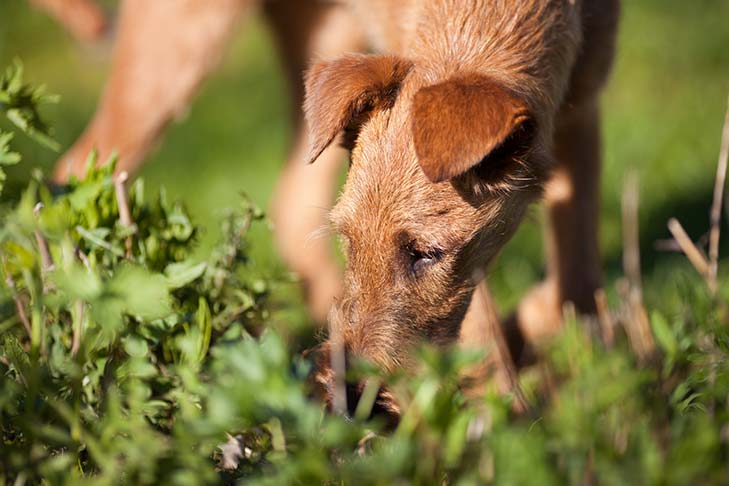
Sometime in spring, when the soil temperature reaches 64 degrees, your dog may suddenly start digging up the yard. They can hear something you can’t yet hear – juvenile cicadas tunneling through the ground getting ready to emerge.
Most of the more than 3,000 types of cicadas appear every 2 to 5 years, and their cycles can vary. But the periodical cicadas spend exactly 13 or 17 years underground, and when they appear, trillions surface, blanketing the ground, cars, trees, and houses. According to entomologists, densities can be as great as 1.5 million cicadas per acre.
After a 17-year hibernation, in 2021, trillions of cicadas emerged in Delaware, Georgia, Illinois, Indiana, Kentucky, Maryland, Michigan, North Carolina, New Jersey, New York, Ohio, Pennsylvania, Tennessee, Virginia, West Virginia, and Washington, D.C. Although the next brood isn’t scheduled to emerge until 2024, some have surfaced early. Dogs may take an interest in cicadas but shouldn’t eat these insects.
Cicadas Can Cause Stomach Upset
Cicadas don’t bite or sting, so no problem – right? Wrong. If you have a dog who likes to munch on whatever can be found on the ground, you need to prepare to stop them from devouring this plentiful treat.
“In most cases, your dog will be fine after eating a few cicadas,” says Dr. Jerry Klein, Chief Veterinary Officer for the AKC. “However, dogs that gorge on the large, crunchy insects will find the exoskeleton difficult to digest and can suffer serious consequences.”
According to Dr. Klein, aftereffects can include severe stomach upset and abdominal pain, vomiting, and bloody diarrhea. Some dogs may require intravenous fluids, pain medications, gastroprotectants, or anti-nausea drugs.

Dogs Overindulging in Cicadas May:
- Experience mild to serious GI upset
- Choke on the stiff wings or hard exoskeleton
- Suffer allergic reactions
- Consume unhealthy amounts of pesticides
How Long Will the Threat Last?
Cicadas live underground for most of their lives, where they drink from plant roots and develop into adults. They emerge from the ground to sing, mate, and lay eggs. The songs, sung mostly by males, can reach 100 decibels. Females lay fertilized eggs in the branches of plants, where they hatch and burrow underground. The adult cicadas die, and the world becomes a little bit quieter.
The cicada cycle will last about 6 weeks, so those emerging in mid-May should be gone by late June, depending on the weather. Then the babies or nymphs will dig into the ground to suck tree roots for another 17 years, although they are now emerging earlier than predicted in some locations.

Of course, those tasty exoskeletons that adult cicadas shed will still be all over the ground. So you’ll need to be vigilant with your dog for a while longer.
Bottom Line on Dogs Eating Cicadas
Preventing your dog from eating cicadas is the safest choice. Get ahead of the game and teach the “leave it” command. And if you have a pup who likes to eat bugs, you’ll need to be a constant companion when they go outside.
This article is intended solely as general guidance, and does not constitute health or other professional advice. Individual situations and applicable laws vary by jurisdiction, and you are encouraged to obtain appropriate advice from qualified professionals in the applicable jurisdictions. We make no representations or warranties concerning any course of action taken by any person following or otherwise using the information offered or provided in this article, including any such information associated with and provided in connection with third-party products, and we will not be liable for any direct, indirect, consequential, special, exemplary or other damages that may result, including but not limited to economic loss, injury, illness or death.

